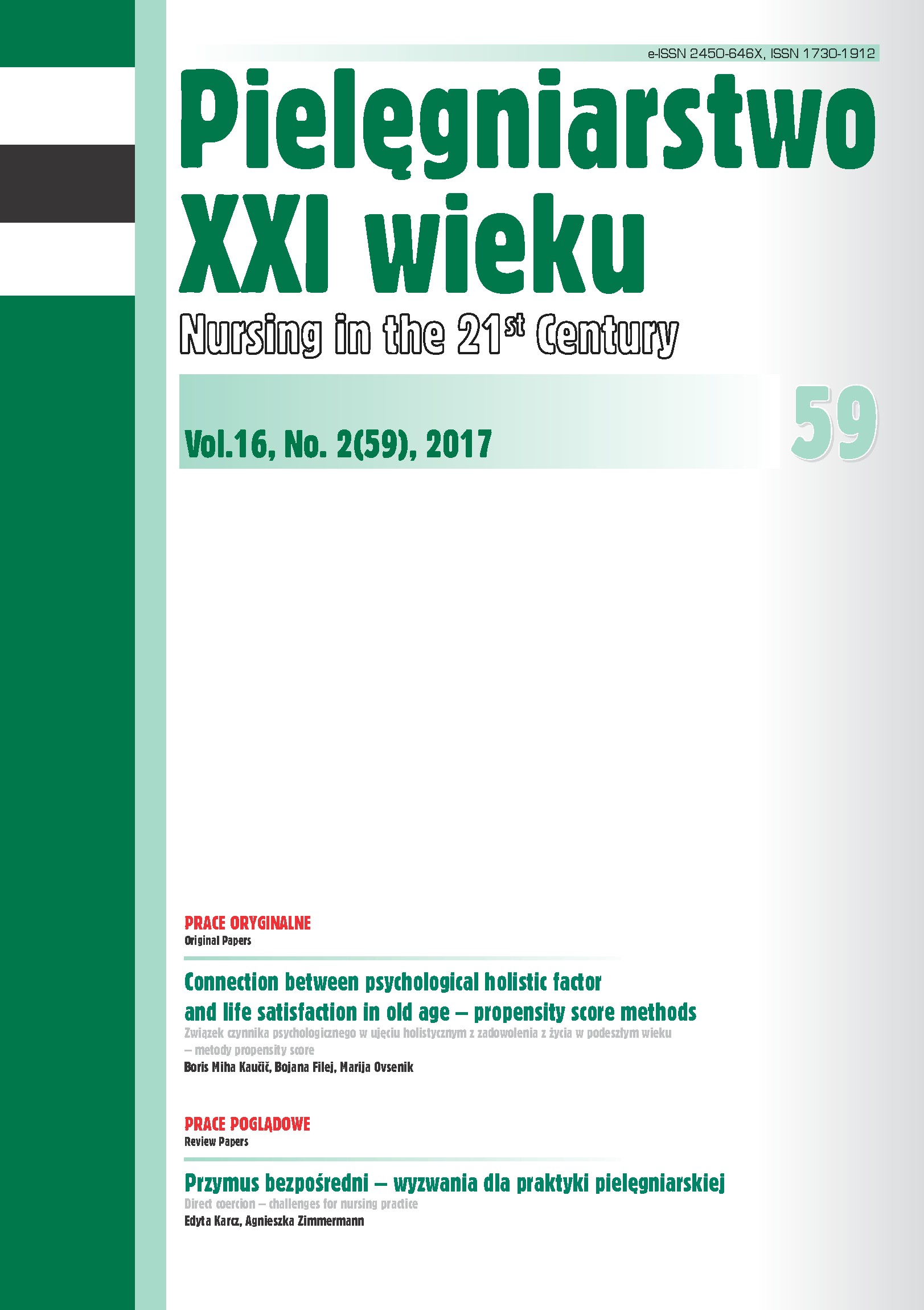Aktualne praktyki w zakresie podstawowych zabiegów resuscytacyjnych u dzieci
DOI:
https://doi.org/10.1515/pielxxiw-2017-0016Słowa kluczowe:
wytyczne RKO, oddychanie ratownicze, uciski klatki piersiowej, automatyczny defibrylator zewnętrznyAbstrakt
AKTUALNE PRAKTYKI W ZAKRESIE PODSTAWOWYCH ZABIEGÓW RESUSCYTACYJNYCH U DZIECI
Wstęp. Mimo, że zatrzymanie akcji serca u dzieci występuje znacznie rzadziej niż u dorosłych, stan ten jest wciąż uważany za poważny problem zdrowotny z niską szansą na przeżycie. Podobnie jak w przypadku dorosłych, przepisy dotyczące czasu resuscytacji krążeniowo-oddechowej (RKO) u dzieci są niezwykle istotne. Aktualne wytyczne dotyczące RKO u dzieci zostały opublikowane wraz z wytycznymi dotyczącymi dorosłych w 2015 roku. Podobnie jak w poprzednich latach, są one oparte na porozumieniu Międzynarodowego Komitetu ds. Resuscytacji. Wytyczne poszczególnych członków tej rady mogą się różnić i odzwierciedlać właściwości regionalne, takie jak, różny dostęp do opieki zdrowotnej, metody edukacji, czy gotowość ludzi do pomocy w nagłych przypadkach. Co więcej, stany wymagające RKO u dzieci nie wyróżniają się jedynie częstotliwością występowania, lecz także etiologią czy technikami stosowanymi u różnych grup wiekowych. W związku z tym nacisk kładziony jest na prostotę i wykonalność, jak również na spójność z wytycznymi dotyczącymi dorosłych w celu poprawy zachowywania odpowiedniej kolejności działań w przypadku dzieci.Pielęgniarki mogą być pierwszymi ratownikami nie tylko w placówkach opieki zdrowotnej. Lepsze zrozumienie wytycznych RKO może przyczynić się do polepszenia ich umiejętności wykrywania stanów wymagających resuscytacji krążeniowo-oddechowej oraz do zapewniania skutecznej pomocy w nagłych przypadkach.
Cel pracy. Celem badania jest porównanie różnych podejść do RKO u dzieci, zwłaszcza do podstawowych zabiegów resuscytacyjnych, stosowanych w aktualnych wytycznych różnych członków Międzynarodowego Komitetu ds. Resuscytacji.
Wyniki i wnioski. Ogólny algorytm do RKO u dorosłych może być stosowany w przypadku ofiar w różnym wieku, lecz w przypadku dzieci, nieco inne podejście może dać dużo bardziej zadawalające efekty.
Bibliografia
1. Berdowski J, Berg RA, Tijssen JG, Koster RW. Global incidences of out-of-hospital cardiac arrest and survival rates: Systematic review of 67 prospective studies. Resuscitation, 2010; 81(11): 1479-1487.
2. Grasner JT, Lefering R, Koster RW, et al. EuReCa ONE-27 Nations, ONE Europe, ONE Registry: A prospective one month analysis of out-of-hospital cardiac arrest outcomes in 27 countries in Europe. Resuscitation. 2016;105: 188-195.
3. Nishiyama C, Brown SP, May S, et al. Apples to apples or apples to oranges? International variation in reporting of process and outcome of care for out-ofhospital cardiac arrest. Resuscitation. 2014; 85(11): 1599-1609.
4. Monsieurs KG, Nolan JP, Bossaert LL, et al. European Resuscitation Council Guidelines for Resuscitation 2015: Section 1. Executive summary. Resuscitation. 2015; 95: 1-80.
5. Nolan JP, Soar J, Zideman DA, et al. European Resuscitation Council Guidelines for Resuscitation 2010 Section 1. Executive summary. Resuscitation. 2010; 81(10): 1219-1276.
6. Nolan JP, Hazinski MF, Aickin R, et al. Part 1: Executive summary. 2015 International Consensus on Cardiopulmonary Resuscitation and Emergency Cardiovascular Care Science with Treatment Recommendation. Resuscitation. 2015; 95: e1-e31.
7. AHA. Highlights of the 2015 American Heart Association Guidelines. Update for CPR and ECC. [online]. 2015, Available from: https://eccguidelines.heart.org/wpcontent/uploads/2015/10/2015-AHA-Guidelines-Highlights-English.pdf.
8. Maconochie IK, Bingham R, Eich C, et al. European Resuscitation Council Guidelines for Resuscitation 2015 Section 6. Paediatric life support. Resuscitation. 2015; 95: 223-248.
9. Atkins DL, Berger S, Duff JP, et al. Part 11: Pediatric Basic Life Support and Cardiopulmonary Resuscitation Quality: 2015 American Heart Association Guidelines Update for Cardiopulmonary Resuscitation and Emergency Cardiovascular Care. Circulation. 2015; 132(18 Suppl 2): S519-525.
10. AHA. Part 11: Pediatric Basic Life Support and Cardiopulmonary Resuscitation Quality. [online]. 2015, Available from: https://eccguidelines.heart.org/index.php/circulation/cpr-ecc-guidelines-2/part-11-pediatric-basic-life-support-andcardiopulmonary-resuscitation-quality/.
11. Goto Y, Maeda T, Goto Y. Impact of dispatcher-assisted bystander cardiopulmonary resuscitation on neurological outcomes in children with out-of-hospital cardiac arrests: a prospective, nationwide, population-based cohort study. Journal of the American Heart Association. 2014; 3(3): e000499.
12. Iwami T, Kitamura T, Kawamura T, et al. Chest compression-only cardiopulmonary resuscitation for out-of-hospital cardiac arrest with public-access defibrillation: a nationwide cohort study. Circulation. 2012; 126(24): 2844-2851.
13. Iwami T, Kitamura T, Kiyohara K, Kawamura T. Dissemination of Chest Compression-Only Cardiopulmonary Resuscitation and Survival After Out-of-Hospital Cardiac Arrest. Circulation. 2015; 132(5): 415-422.
14. Kitamura T, Iwami T, Kawamura T, et al. Conventional and chest-compression-only cardiopulmonary resuscitation by bystanders for children who have out-of-hospital cardiac arrests: a prospective, nationwide, population-based cohort study. The Lancet. 2010; 375(9723): 1347-1354.
15. Maconochie IK, de Caen AR, Aickin R, et al. Part 6: Pediatric basic life support and pediatric advanced life support. 2015 International Consensus on Cardiopulmonary Resuscitation and Emergency Cardiovascular Care Science with Treatment Recommendations. Resuscitation. 2015; 95: e147-e168.
16. ANZCOR. ANZCOR Guideline 8 - Cardiopulmonary Resuscitation. [online]. 2016, Available from: https://resus.org.au/guidelines/.
17. ANZCOR. All Paediatric Advanced Life Support guidelines. [online]. 2016, Available from: http://www.nzrc.org.nz/assets/Uploads/Guidelines/Paed-ALS/All-Paed-ALSguidelines-Jan-2016.pdf.
18. ANZCOR. ANZCOR Guideline 2 - Managing an Emergency. [online]. 2016, Available from: https://resus.org.au/guidelines/.
19. ANZCOR. ANZCOR Guideline 5 – Breathing. [online]. 2016, Available from: https://resus.org.au/guidelines/.
20. ANZCOR. ANZCOR Guideline 3 - Recognition and First Aid Management of the Unconscious Person. [online]. 2016, Available from: https://resus.org.au/guidelines/.
21. ANZCOR. ANZCOR Guideline 4 – Airway. [online]. 2016, Available from: https://resus.org.au/guidelines/.
22. Lubrano R, Cecchetti C, Bellelli E, et al. Comparison of times of intervention during pediatric CPR maneuvers using ABC and CAB sequences: A randomized trial. Resuscitation. 2012; 83(12): 1473-1477.
23. Marsch S, Tschan F, Semmer NK, et al. ABC versus CAB for cardiopulmonary resuscitation: a prospective, randomized simulator-based trial. Swiss Medical Weekly. 2013; 143: w13856.
24. Deasy C, Bernard SA, Cameron P, et al. Epidemiology of paediatric out-of-hospital cardiac arrest in Melbourne, Australia. Resuscitation. 2010; 81(9): 1095-1100.
25. ANZCOR. ANZCOR Guideline 6 – Compressions. [online]. 2016, Available from: https://resus.org.au/guidelines/.
26. Sutton RM, French B, Niles DE, et al. 2010 American Heart Association recommended compression depths during pediatric in-hospital resuscitations are associated with survival. Resuscitation. 2014; 85(9): 1179-1184.
27. Maher KO, Berg RA, Lindsey CW, et al. Depth of sternal compression and intra-arterial blood pressure during CPR in infants following cardiac surgery. Resuscitation. 2009; 80(6): 662-664.
28. ANZCOR. ANZCOR Guideline 7 - Automated External Defibrillation in Basic Life Support. [online]. 2016, Available from: https://resus.org.au/guidelines/.
Opublikowane
Numer
Dział
Licencja
Prawa autorskie (c) 2017 Autorzy

Praca jest udostępniana na licencji Creative Commons Attribution-NonCommercial-NoDerivatives 3.0 Unported License.




